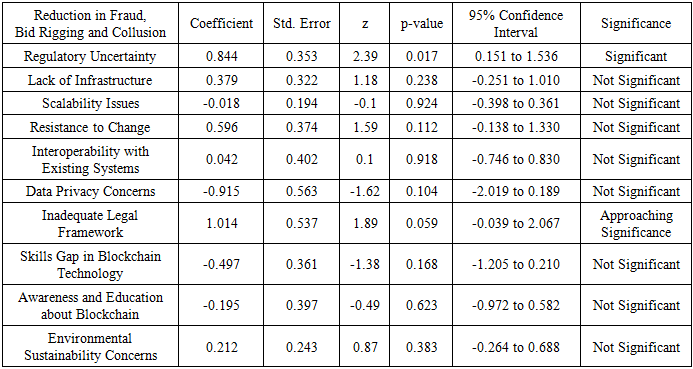-
Paper Information
- Paper Submission
-
Journal Information
- About This Journal
- Editorial Board
- Current Issue
- Archive
- Author Guidelines
- Contact Us
Management
p-ISSN: 2162-9374 e-ISSN: 2162-8416
2025; 15(1): 55-65
doi:10.5923/j.mm.20251501.03
Received: Jul. 17, 2025; Accepted: Aug. 16, 2025; Published: Sep. 2, 2025

Blockchain Technology Potentials for Malpractices Mitigation in Nigeria’s Public Infrastructure Procurement System
Folushola O. Dolire, Rex A. Ugulu, Ndubuisi U. Okereke
Procurement Management, Centre of Excellence in Sustainable Procurement, Environmental and Social Standards, Federal University of Technology Owerri, Imo State, Nigeria
Correspondence to: Folushola O. Dolire, Procurement Management, Centre of Excellence in Sustainable Procurement, Environmental and Social Standards, Federal University of Technology Owerri, Imo State, Nigeria.
| Email: |  |
Copyright © 2025 The Author(s). Published by Scientific & Academic Publishing.
This work is licensed under the Creative Commons Attribution International License (CC BY).
http://creativecommons.org/licenses/by/4.0/

The pervasiveness of corruption, inefficiency, and lack of accountability in public procurement systems has significant implications for economic growth and public trust, particularly in developing countries like Nigeria. This work quantitatively investigated the potential of blockchain technology to address malpractices in public infrastructure procurement. The study utilized a survey-based research design, which involved collecting data from a diverse group of respondents that includes procurement professionals, policymakers, blockchain technology experts, and other stakeholders from various sectors in Nigeria. To analyze the data, the study employed a range of statistical techniques, such as descriptive statistics, regression models, and factor analysis. These analyses aimed to evaluate the potential of blockchain technology's key attributes – transparency, immutability, and decentralization – to enhance procurement practices. The results revealed significant positive correlations between blockchain adoption and improvements in procurement transparency, accountability, and efficiency. Regression analysis pinpointed specific organizational and technological factors that influenced the likelihood of blockchain integration, such as stakeholder readiness, regulatory frameworks, and perceived benefits. Furthermore, factor analysis identified key barriers to adoption such as resistance to change and capacity gaps, which provided a comprehensive understanding of the challenges in implementing blockchain solutions in public procurement. This research contributed to the growing body of knowledge on the application of blockchain in governance by offering data-driven perspectives into its potential for transforming procurement processes in Nigeria. The findings provided actionable recommendations for policymakers and practitioners to foster blockchain adoption and emphasized the need for supportive regulations, capacity-building initiatives, and stakeholder engagement to achieve a more transparent and efficient procurement system.
Keywords: Procurement, Blockchain, Transparency, Immutability, Decentralization, Correlations, Stakeholder readiness, and technological factors
Cite this paper: Folushola O. Dolire, Rex A. Ugulu, Ndubuisi U. Okereke, Blockchain Technology Potentials for Malpractices Mitigation in Nigeria’s Public Infrastructure Procurement System, Management, Vol. 15 No. 1, 2025, pp. 55-65. doi: 10.5923/j.mm.20251501.03.
Article Outline
1. Introduction
- Public infrastructure procurement in Nigeria is a critical aspect of governance which involves the acquisition of goods, services, and construction works by government entities. However, the sector is plagued by malpractices such as bid rigging, bribery, and fraud, which undermine public trust and hinder socio-economic development [1], [2]. Despite the existence of legislative and regulatory frameworks, these challenges persist which reflects a fundamental gap in the effectiveness of the current procurement systems. The problem lies in the inability of existing mechanisms to ensure transparency, accountability, and integrity in public procurement processes. A solution approach to this problem is the adoption of blockchain technology, which offers the potential to enhance transparency, accountability, and integrity in procurement processes. The decentralized and immutable nature of blockchain transactions have been featured as having the capacity to mitigate the risks of corruption and fraud, thereby improving the efficiency and effectiveness of public infrastructure procurement [3]. According to [4], public procurement in Nigeria accounts for over 80% of government expenditures at both national and subnational levels, with governments spending an estimated 10–25% of GDP on goods, services, and works. Unfortunately, this significant expenditure is undermined by growing corruption and inefficiencies in procurement practices.Recognizing this critical issue, this research investigated the potential of blockchain technology as an innovative solution to address malpractices in public infrastructure procurement in Nigeria. While blockchain has been successfully applied in other domains to promote accountability and reduce malpractices, its application in the public infrastructure procurement sector in Nigeria remains largely underexplored.According to the world bank, a marginal gain in value from a procurement process can be a major source of economic benefit to the nation considering the size of government procurement market relative to the GDP. As opined by [5], quality-related problems in public infrastructures are direct result of unprofessional malpractices exhibited by entrusted public officials. Public procurement researchers have attributed the prevalence of malpractice to the nature of public procurement. Widespread malpractices are due in part to the discretionary nature of procurement and therefore transcends geographical boundaries [6]. Attempts have been made to explore legal instruments and procurement codes to limit officials’ default to discretionary [7], since it fuels corruption, but noting further [6] observed that “over-regulation results in purchasing for process rather than value, and this constrains the achievement of the procurement performance”. Furthermore, in their work [7] concluded with evidence that discretion when applied in negotiations leads to operational efficiency.While there is not available peer-reviewed academic literature that specifically addressed the topic of blockchain technology use case in eliminating malpractices in public infrastructure procurement in Nigeria, few studies in the construction industry have been conducted that evaluated the prevalence of procurement-related malpractices in Nigeria, [8] and [9]. Author [8] semantically listed collusive tendering, inflated contract sum, bribery and forgery and shoddy construction works as malpractices, [10], [11], [12]. From building projects studied by [8] and the e-procurement work using blockchain technology [13], the authors agreed to the presence of petty and grand corruptions. The present study aims to provide practical solutions that enhance ethical standards, promote transparency, and contribute to sustainable development. To protect the taxpayers from economic loses occasioned by weak public procurement processes, authorities can leverage database and distributed technologies like blockchain to mitigate the risk of erosion of public trust in governance [14].Despite the establishment of a handful of anti-corruption bodies and regulatory agencies, the spate of procurement related fraud has exacerbated. According to [15], contract and procurement fraud in Nigeria between 2018 and 2020 is estimated at 2.9 trillion naira (USD 7.6 billion); noting further that this amount represents 10% of Nigeria’s total fiscal budgets over the same period. Efforts to leverage traditional methods of monitoring and auditing to mitigate corruption have proven ineffectual, inadequate and gross waste of national resources. Blockchain will enable governments at the national and subnational levels to design-out malpractices in their infrastructure development planning programmes. This research is timely, driven by growing public demands for stronger oversight and accountability in government spending, particularly as taxpayers finance a substantial share of public projects [16]. The findings from this study offered a point of departure for policymakers, procurement practitioners, and other stakeholders to embrace blockchain technology as a tool for transforming Nigeria's public procurement landscape.
2. Literature Review
- Public procurement, as a key tool in public administration and governance, primarily focuses on identifying needs to address broader societal expectations while advancing social, economic, and ecological goals. Public policy formulation and governance often require significant system integration through processes, guidelines, protocols, and bureaucratic structures to manage state resources effectively. As an innovation-driven model, integrating public procurement with advanced technologies such as blockchain offers a promising perspective on addressing the challenges of public administration. This study reviews relevant scholarly literature to explore the connection between blockchain technology and public procurement.The methodology of the literature review for investigating blockchain technology's potential in Nigeria’s public procurement involved a systematic approach to identify, select, and analyze relevant literature. A comprehensive search strategy is developed, and research is conducted across various academic databases to retrieve peer-reviewed articles, conference papers, white papers and industry reports. Screening of search results is performed based on predefined inclusion and exclusion criteria. Selected studies undergo full-text assessment, considering factors such as methodology, relevance, and quality. Data extraction and synthesis involve extracting key findings and synthesizing them to identify patterns and gaps in the literature. Critical analysis evaluates the strengths and limitations of selected studies, which contribute to the organization and presentation of the literature review. Periodic revision ensures the review's relevance and comprehensiveness. This methodology ensures a rigorous and structured approach to exploring blockchain's potential in addressing malpractices in Nigerian public procurement. In their work [17], in [18] they argued that public procurement is a demand-side instrument for the promotion of innovative solutions. Apart from being a demand-side innovation driver, public procurement is described as a complex policy instrument which requires significant capabilities and institutional ingredient necessary to make a change [17].While developing her own legal and regulatory instruments, Nigeria benefited in content from the 1994 UNCITRAL Model Law on Procurement of Goods, Construction and Service, although this is now being replaced by the much recent 2011 Model Law. The enabling laws, according to [19], began in most parts of the world in the 1990s and 2000s. In Nigeria public sector procurement is backed by the provisions of the Public Procurement Act of 2007. Demand for transparency, fairness and value for money has led to significant improvement in procurement practice in Nigeria as government and multilateral stakeholders worked together to change the narratives through legislative reforms, advocacy, and capacity building. Since its amendment in 2016 the Act empowers the Bureau of Public Procurement to function as the oversight body to regulate the conduct of federal procuring authorities.
2.1. Improved Public Infrastructure Procurement and Elimination of Malpractices
- Improved public infrastructure procurement in Nigeria can significantly benefit from integrating blockchain technology by driving key dependent variables such as transparency, accountability, and efficiency. Transparency in procurement processes ensures that all transactions and decisions are visible to enable a traceable process which mitigates the opportunities for malpractices such as bribery, fraudulent practices, and non-disclosure. Blockchain technology provides an immutable ledger that records all transactions, making it difficult to alter or hide information [20]. This level of transparency not only deters corrupt practices but also builds trust among stakeholders, ensuring that procurement processes are conducted fairly and openly [21].Accountability is another critical metrics in public infrastructure procurement evaluation. Blockchain's decentralized and transparent nature ensures that all actions are recorded and can be audited [22]. Smart contracts [23], built on blockchain technology act as extra layer of automation and security that fires when nodes come to consensus to reduce the possibility of human error or manipulation [6]. A set of criteria are validated in a smart contract program like Ethereum Virtual Machine before executing the agreed upon terms [3].Efficiency in public infrastructure procurement can be significantly improved using blockchain technology. Traditional procurement processes often involve lengthy procedures and numerous intermediaries, leading to delays and increased costs. Blockchain streamlines these processes by automating transactions and reducing the need for intermediaries. This not only speeds up the procurement cycle but also reduces administrative costs, making the entire process more efficient. On the global stage, there are a handful of nations and institutions that are already pioneering the adoption of blockchain technology to manage public sector procurement. The United States has used ‘Accelerate’ to managed contract billing in their Health and Human Services department [3], Estonia, for example, has integrated blockchain technology into its e-Government services to ensure data integrity and verifiable transactions across multiple public sectors which include public procurement [24]. Blockchain-backed procurement was implemented in Aragon, Spain, to enhance transparency, security of data and integrity in public procurement with specific focus on vendor selection and management [25]. These international experiences [26] demonstrate that blockchain adoption in procurement can yield measurable benefits in efficiency, trust, and fraud prevention, providing valuable lessons for Nigeria’s context.
2.2. Challenges and Considerations
- While blockchain offers significant potential benefits for public infrastructure procurement, several challenges must be addressed. Navigating the implementation of blockchain technology in public infrastructure procurement management presents several challenges and considerations in recent research. One significant challenge is scalability, as blockchain networks may struggle to handle the volume of transactions required in large-scale public procurement management systems [27]. Another issue is interoperability, where different blockchain platforms and systems may not seamlessly communicate or integrate with each other, posing hurdles for widespread adoption [28]. Moreover, regulatory uncertainty and compliance issues present ongoing challenges, with varying legal frameworks globally impacting the deployment of blockchain solutions in contract management [29]. Security concerns also persist, particularly around data privacy and the potential vulnerabilities of smart contracts to manipulation [30], [31]. Addressing these challenges requires ongoing research and development to enhance blockchain's capabilities and ensure its effective integration into contract management practices.
3. Methodology
3.1. Description of Study Area
- Nigeria, located in West Africa, is the most populous country in Africa and has significant economic influence in the region. The country's geographic expanse covers 923,768 square kilometers, characterized by diverse landscapes ranging from arid regions in the north to coastal regions in the south. Nigeria's administrative structure is divided into 36 states and the Federal Capital Territory (FCT), Abuja. Each state is further subdivided into local government areas (LGAs), amounting to a total of 774 LGAs nationwide.Public procurement processes are regulated by the Public Procurement Act of 2007, which established the Bureau of Public Procurement (BPP) and National Council on Public Procurement. The BPP is responsible for the oversight, management and regulation of public procurement practices to ensure transparency, accountability, and value for money. Despite these regulatory frameworks, public procurement in Nigeria has historically been plagued by bribery, fraud, nepotism and inefficiencies. The study focused on public procurement processes within key sectors of Nigeria’s economy, namely transportation, energy, health, and education. These sectors are vital to Nigeria’s development, as they directly impact the quality of life of its citizens and the overall economic growth. Specifically, the research examined procurement activities in the geopolitical zones of Nigeria – North East, North West, North Central, South-South, South West and South East. The intent is to cover the geographical spread of the country. This diverse geographical and administrative focus allowed the study to capture a wide range of procurement practices and their associated malpractices. The goal was to understand how blockchain technology could be applied across different settings to enhance the transparency and efficiency of public procurement processes.
3.2. Research Design
- This study employed a quantitative research approach to investigate the potential of blockchain technology in eliminating malpractices in public infrastructure procurement in Nigeria. Quantitative research provides a systematic method for collecting and analyzing numerical data, enabling the identification of patterns, relationships, and insights relevant to the research problem. Scholars have emphasized the importance of quantitative methods in delivering objective and generalizable findings, which are essential for addressing complex social and organizational challenges [32].
3.3. Study Population
- The study population for investigating the potential of blockchain technology in eliminating malpractices in public infrastructure procurement in Nigeria comprises a diverse group of stakeholders directly or indirectly involved in the procurement process. This includes individuals and organizations that play crucial roles in planning, technology, execution, oversight, and evaluation of public procurement activities. The present study derived its sampling modeling technique from the work of researchers [33] in their investigation of sample sizes based on predetermined populations. The authors, [33] asserted that Krejcie and Morga’s equation (and standard table) of 1970 are sufficient to determine the representative sample of a given population. The formula incorporates a predefined confidence level (typically 95%) and a margin of error (usually 5%), making it suitable when these parameters are essential for the research design. The Krejcie and Morga’s formula ensures that the sample size is large enough to provide a representative sample, which is crucial for generalizing the findings to the entire population. Thus, the present study selected 80 procurement professionals and other stakeholders involved in blockchain technology and public infrastructure procurement activities. Krejcie and Morgan in 1970, cited by [33], [34], presented the model below for use in quantitative research studies:
 | (3.1) |
 is the table value of chi-square for 1 degree of freedom at the desired confidence level (3.841 for 95% confidence level) N is the population sizeP is the population proportion (assumed to be 0.5 for maximum sample size)d is the degree of accuracy expressed as a proportion (0.05)For this study, N = 80,
is the table value of chi-square for 1 degree of freedom at the desired confidence level (3.841 for 95% confidence level) N is the population sizeP is the population proportion (assumed to be 0.5 for maximum sample size)d is the degree of accuracy expressed as a proportion (0.05)For this study, N = 80, 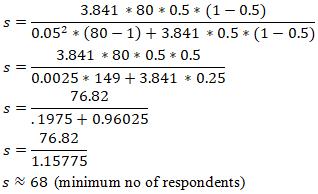 Therefore, the number of respondents (or sample size) used in the study was 68.
Therefore, the number of respondents (or sample size) used in the study was 68.3.4. Sampling Size
- The sample size chosen for the study was 68 respondents who are a combination of procurement professionals, contractors, blockchain experts and other stakeholders. According to [35], determining adequate sample size from a population is one of the most fundamental tasks in research. Authors [35], argued further that a valid generalization is dependent on the sample size, citing Bartlett, Kotrlik and Higgins in their 2001 work on organizational research.
3.5. Sampling Technique
- Simple random sampling and stratified random sampling techniques were used. The simple random sampling help ensured that the sample is representative of the entire population, minimized bias and allow for the generalization of the results to the broader population [36]. Stratified random sampling, enabled the formation of subgroups for stakeholders that share similar characteristics, and then randomly selecting samples from each stratum [37]. The stratified random sampling method was adopted because of the heterogeneous nature of the study. The goal was to ensure that each subgroup is adequately represented in the sample [8]. The population was divided into different strata based on key characteristics relevant to the study. The strata included:i. Procurement officers: Individuals responsible for managing procurement processes within various government ministries and agencies.ii. Policymakers: Officials involved in formulating procurement policies and regulations.iii. Bureau of Public Procurement (BPP) officials: Representatives from the central regulatory authority overseeing public procurement activities in Nigeria.iv. Industry experts and consultants: Professionals with expertise in blockchain technology and public procurement.v. Academia and research institutions: Scholars and researchers providing analytical frameworks and unbiased evaluations.This approach ensured that the sample included diverse perspectives from all relevant groups thereby enhanced the representativeness and reliability of the findings [8], [36].
3.6. Data Collection Methods
- To explore the capability of blockchain technology to mitigate malpractices in public infrastructure procurement, an interpretivist philosophical position elicited by [38] was adopted in the literature review sections. This enabled the factors identified from the literature, research questions and research objectives to be aligned to suit the study’s aim. A questionnaire survey instrument was then prepared, premised upon the conceptual framework developed from an intensive investigation of contemporary literature and synthesis of the research objectives. Questionnaire surveys are widely utilized by researchers to investigate factors that influence the adoption of technology and measure the outcomes based on the opinions and attitudes of respondents as noted by [39], citing Howard and fellow researchers in their 2017 work on individual perceptions. According to [39], this strategy is critical to building extensive knowledge stemming from the experiences of others. Structured surveys consisting of opened and closed-ended questions were integrated to collect primary quantitative data. These surveys were randomly distributed electronically to a broad range of respondents, including procurement officers, policymakers, industry experts, and representatives from the Bureau of Public Procurement (BPP). The surveys were designed to capture perceptions, experiences, and insights regarding the integration of blockchain technology in public procurement processes. The questionnaire consisted of a 5-point Likert-type rating scale (1 = strongly disagree and 5 = strongly agree) that were used to solicit knowledge and opinions of the survey respondents. Developed in 1932 by Rensis Likert to measure attitudes, the typical Likert scale is a 5-scale used by respondents to rate the degree to which they agree or disagree with a statement presented to them [40].Semi-structured interviews were conducted to gather qualitative data, following the views presented by [41] since qualitative evidence synthesis requires thorough evaluation. These interviews provided a deeper understanding of malpractices in public procurement, the challenges and benefits of blockchain implementation from the perspectives of key stakeholders [38]. Conducted both in person and via virtual platforms, the interviews allowed for flexibility and in-depth exploration of specific issues raised by the survey data.
3.7. Methods of Data Analysis
- Data analysis used for this study involved quantitative to thoroughly examine the potential for blockchain technology to mitigate malpractices in public infrastructure procurement in Nigeria. Regression Analysis: Multiple regression analysis was conducted to understand the influence of various independent variables (e.g., regulatory frameworks, procurement practices, stakeholder engagement, and use of technology) on the dependent variables (transparency, accountability, efficiency, and malpractices such as bribery, kickbacks, fraud, collusion, conflict of interest, bid rigging, embezzlement, nepotism, non-disclosure, bid splitting, misuse of confidential information, front companies, and ghost contracts) in public procurement. This analysis helped in identifying key factors that significantly impact procurement malpractices and estimating the strength and direction of these relationships [42]. This model provided insights into how different aspects of the procurement process contribute to the overall integrity and effectiveness of public infrastructure projects [43].The Software tools, IBM SPSS (Statistical Package for the Social Sciences) and MS Excel were used to analyze quantitative data.
3.8. Reliability Analysis of Research Instrument Using Cronbach’s Alpha Coefficient
- Reliability analysis is a crucial aspect of research methodology that assesses the consistency and stability of the measurement instruments used in a study [39]. In this research, the reliability of the structured survey instruments was evaluated using Cronbach's Alpha coefficient, which measures the internal consistency of the items within a scale.For this study, the reliability analysis was conducted on the survey items related to the independent variables (regulatory frameworks, procurement practices, stakeholder engagement, and use of technology) and dependent variables (transparency, accountability, efficiency, and malpractices such as bribery, kickbacks, fraud, collusion, conflict of interest, bid rigging, embezzlement, nepotism, non-disclosure, bid splitting, misuse of confidential information, front companies, and ghost contracts).The survey data were analyzed using statistical software, which calculated Cronbach's Alpha for each scale. The results indicated that the survey instruments were highly reliable, with most scales achieving an Alpha value of above 0.7. This high reliability ensures that the data collected is consistent and dependable, thereby strengthening the validity of the research findings.The reliability analysis confirmed that the measurement instruments used in the study were consistent and accurate in capturing the necessary data. This reliability is critical in ensuring that the conclusions drawn about the potential for blockchain technology to enhance transparency, efficiency, and accountability in Nigeria's public infrastructure procurement processes are based on solid and dependable data. By establishing the reliability of the survey instruments, the study underscores the robustness of its methodological approach and the credibility of its findings.
4. Results and Discussions
4.1. Analysis of Reliability Statistics
- In this study a pre-test study was conducted to evaluate the reliability of the instrument of data gathering. In the data output shown in Table 1, a total of 25 data points were used in the assessment of data instruments to check for internal consistency. The reliability analysis indicates a high degree of internal consistency in the 25-item measurement scale used in this study, according to Table 1 with a Cronbach's Alpha value of 0.855. This value surpasses the commonly accepted threshold of 0.7 [39] which demonstrates that the items are well-correlated and measure the same underlying construct effectively. High reliability enhances the credibility of the data collected and strengthens the confidence in the scale’s ability to produce consistent results across different populations or settings [44].
|
4.2. Descriptives Statistics of Demographic Data
- The demographic profile of the respondents reflects a well-distributed representation across key stakeholders involved in public infrastructure procurement in Nigeria. Participants were drawn from public agencies, private contractors, and independent consultants to provide a result that captures a broad spectrum of views and biases along different worldviews.
4.2.1. Higher Educational Qualification
- According to Figure 1, 23% of respondents have a Higher National Diploma (HND). This group represents 23.5% of the total respondents. Also, 18 respondents (26.5%) hold a Bachelor of Science (BSc) degree. This group makes up 26.5% of the total respondents. MSc: 21 respondents (30.9%) have a Master of Science (MSc) degree.
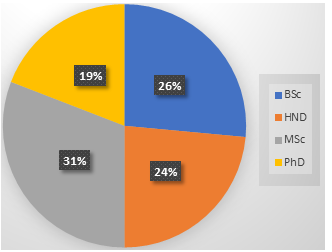 | Figure 1. Highest educational qualification. (Source: Field Survey 2024) |
4.2.2. Years of Experience in Public Infrastructure Procurement
- As shown in Figure 2, the data depicts a diverse range of experience levels among respondents, with the majority having 5 to 10 years of experience. There is a gradual decrease in frequency as the years of experience increase, but a notable portion still has over 21 years of experience. This distribution suggests a workforce with a strong foundation of mid-level experience, complemented by a significant number of highly experienced individuals.
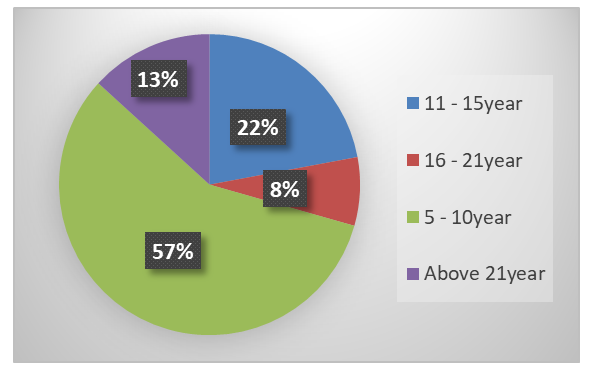 | Figure 2. Years of experience. (Source: Field Survey 2024) |
4.2.3. Age of Respondents
- The age distribution as shown in Figure 3, 4.4% are 18-24 years, 32.4% are 25-34 years, 42.6% are 35-44 years, 14.7% are 45-54 years, and 5.9% are 55 and above. It is important to note according to Figure 3 that younger age groups (18-34 years), representing 36.8% of the respondents, are typically more open to adopting new technologies due to their familiarity and comfortability with digital tools. The middle age group (35-44 years) in Figure 3, the largest segment at 42.6%, often balances experience with openness to new technology, making them crucial for technology adoption in professional settings. Older age groups (45 and above), comprising 20.6%, may be more resistant to change but can adopt technology with proper training and support.
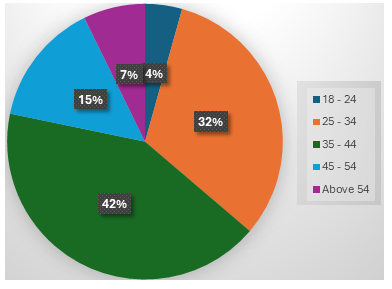 | Figure 3. Age Distribution of respondents. (Source: Field Survey 2024) |
4.2.4. Gender of Respondents
- Figure 4 shows the gender distribution of 72% male and 28% female which shows critical gender gap in blockchain technology adoption. This disparity underscores the importance of fostering diversity, as balanced perspectives are crucial for inclusive and effective adoption strategies.
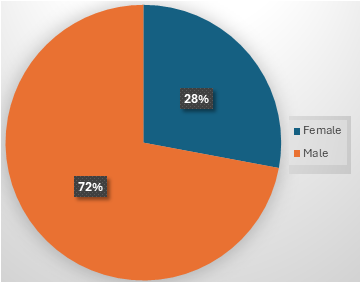 | Figure 4. Gender distribution of respondents. (Source: Field Survey 2024) |
4.2.5. Role of Respondent in the Public Procurement Process
- The distribution in Figure 5. highlights the diverse range of stakeholders involved in public procurement, with a significant presence of professionals directly managing procurement processes, researchers contributing academic insights, government officials overseeing regulations, and technology experts driving innovation through blockchain.
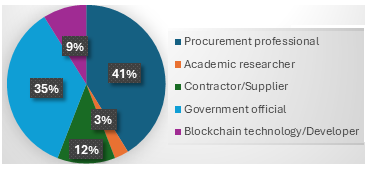 | Figure 5. Role of Respondent in the Public Procurement Process |
4.2.6. Blockchain Technology Adoption Reduce Fraud, Bid Rigging, and Collusion in Procurement
- The data presented in Table 2 signposts the perceived impact of blockchain technology on fraud reduction, bid rigging, and collusion in procurement. Among the respondents, the majority, 49.3%, rated the technology as having a "Very High Significance" in addressing these malpractices. This result underscores the optimism surrounding blockchain's potential to enhance transparency and accountability in public and private procurement processes. The high level of confidence may stem from blockchain’s inherent characteristics, such as immutability, decentralized verification, and traceability, which are pivotal in minimizing opportunities for corrupt practices.
|
4.2.7. Blockchain Significance in the Promotion of Transparency in Public Procurement
- Blockchain fosters transparency by creating an immutable and accessible ledger of procurement activities, making it easier to audit processes and deter corruption. The data in Table 3 indicates that promoting transparency in public procurement is considered highly significant by a vast majority of respondents surveyed. A total of 100% of respondents believe that blockchain technology-backed transparency is of moderate to very high significance, with 70.1% assigning it high significance and 29.9% considering it very highly significant.
|
4.2.8. Improved Accountability Through Blockchain Adoption
- The data in Table 4. indicates that blockchain improved accountability is considered highly significant by most respondents. A total of 62.7% (44.8% + 17.9%) of respondents believe that improved accountability is of high or very high significance, with 44.8% assigning it very high significance. Blockchain ensures every transaction is traceable and therefore enhances accountability among stakeholders – public officials and contractors can be held responsible for their actions.
|
4.2.9. Blockchain on Reduction of Fraud, Bid Rigging and Collusion
- The factors influencing the reduction of fraud, bid rigging, and collusion in public Procurement through blockchain technology is assessed in this section of the report. Regulatory Uncertainty (Coef: 0.844, p = 0.017), shown in Table 5, emerged as a significant positive predictor by suggesting that improved unambiguous regulatory clarity can greatly reduce procurement malpractices. Similarly, inadequate legal framework (coef: 1.014, p = 0.059) approached significance which suggests that a robust legal structure could play a critical role in achieving fairness and reducing collusion.
|
5. Conclusions and Rcommendations
- The research concludes that blockchain technology holds significant promise in transforming Nigeria’s public infrastructure procurement system by ensuring greater transparency, reducing opportunities for corruption, and improving accountability. The findings suggest that blockchain’s decentralized nature and immutability make it a viable solution to address issues such as bid rigging, misallocation of funds, and lack of oversight in procurement processes. It aligns with widely held views that the adoption of blockchain could restore public trust and attract investments in infrastructure development.The study offers empirical evidence on the potential of blockchain technology to mitigate persistent challenges such as corruption, inefficiency, and lack of transparency within Nigeria’s public procurement system. Through the application of blockchain principles, public procurement can evolve from a routine administrative function into a strategic policy instrument that enhances technological implementation and deepens trust between the government and its citizens. This research introduces an innovative approach to curbing procurement malpractices and demonstrates how decentralized and immutable recordkeeping can significantly reduce fraud and enhance accountability. On the strength of this study, it is recommended that the Nigerian government creates a national strategy to pilot blockchain technology in public procurement, by focusing on key infrastructure sectors such as construction, power plants and health services. Governments at both national and subnational levels should therefore forge collaborative partnerships with technology providers, non-governmental organizations and regulatory institutions to ensure effective implementation.
 Abstract
Abstract Reference
Reference Full-Text PDF
Full-Text PDF Full-text HTML
Full-text HTML



